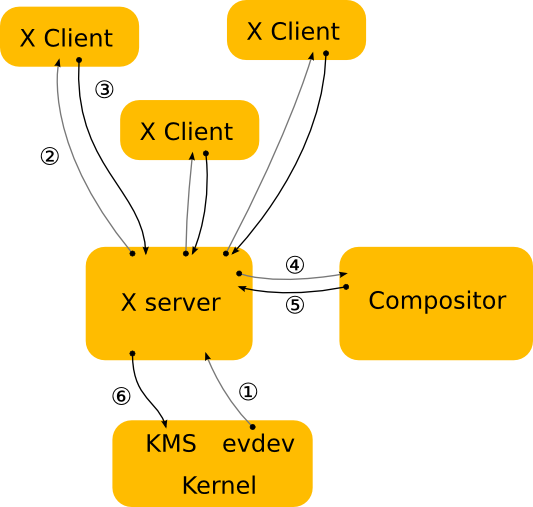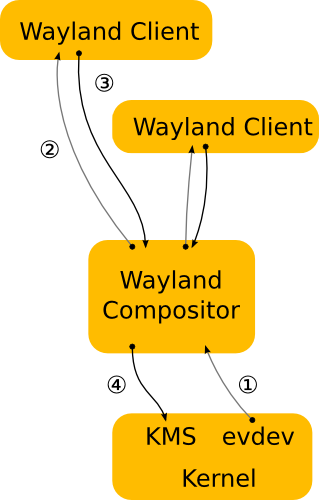Chapter 1. Wayland Architecture
1.1. X vs. Wayland Architecture
A good way to understand the wayland architecture and how it is different from X is to follow an event from the input device to the point where the change it affects appears on screen.
This is where we are now with X:
The kernel gets an event from an input device and sends it to X through the evdev input driver. The kernel does all the hard work here by driving the device and translating the different device specific event protocols to the linux evdev input event standard.
The X server determines which window the event affects and sends it to the clients that have selected for the event in question on that window. The X server doesn't actually know how to do this right, since the window location on screen is controlled by the compositor and may be transformed in a number of ways that the X server doesn't understand (scaled down, rotated, wobbling, etc).
The client looks at the event and decides what to do. Often the UI will have to change in response to the event - perhaps a check box was clicked or the pointer entered a button that must be highlighted. Thus the client sends a rendering request back to the X server.
When the X server receives the rendering request, it sends it to the driver to let it program the hardware to do the rendering. The X server also calculates the bounding region of the rendering, and sends that to the compositor as a damage event.
The damage event tells the compositor that something changed in the window and that it has to recomposite the part of the screen where that window is visible. The compositor is responsible for rendering the entire screen contents based on its scenegraph and the contents of the X windows. Yet, it has to go through the X server to render this.
The X server receives the rendering requests from the compositor and either copies the compositor back buffer to the front buffer or does a pageflip. In the general case, the X server has to do this step so it can account for overlapping windows, which may require clipping and determine whether or not it can page flip. However, for a compositor, which is always fullscreen, this is another unnecessary context switch.
As suggested above, there are a few problems with this approach. The X server doesn't have the information to decide which window should receive the event, nor can it transform the screen coordinates to window local coordinates. And even though X has handed responsibility for the final painting of the screen to the compositing manager, X still controls the front buffer and modesetting. Most of the complexity that the X server used to handle is now available in the kernel or self contained libraries (KMS, evdev, mesa, fontconfig, freetype, cairo, Qt etc). In general, the X server is now just a middle man that introduces an extra step between applications and the compositor and an extra step between the compositor and the hardware.
In wayland the compositor is the display server. We transfer the control of KMS and evdev to the compositor. The wayland protocol lets the compositor send the input events directly to the clients and lets the client send the damage event directly to the compositor:
The kernel gets an event and sends it to the compositor. This is similar to the X case, which is great, since we get to reuse all the input drivers in the kernel.
The compositor looks through its scenegraph to determine which window should receive the event. The scenegraph corresponds to what's on screen and the compositor understands the transformations that it may have applied to the elements in the scenegraph. Thus, the compositor can pick the right window and transform the screen coordinates to window local coordinates, by applying the inverse transformations. The types of transformation that can be applied to a window is only restricted to what the compositor can do, as long as it can compute the inverse transformation for the input events.
As in the X case, when the client receives the event, it updates the UI in response. But in the wayland case, the rendering happens in the client, and the client just sends a request to the compositor to indicate the region that was updated.
The compositor collects damage requests from its clients and then recomposites the screen. The compositor can then directly issue an ioctl to schedule a pageflip with KMS.



